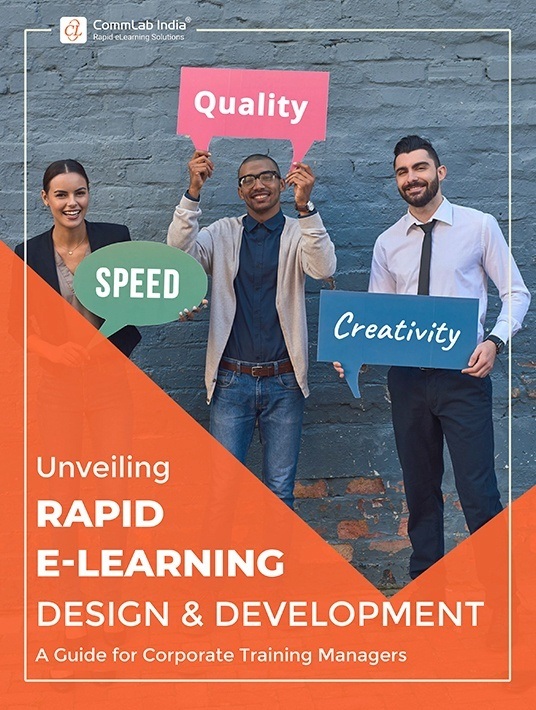The All-In-One Rapid eLearning Design And Development Guide For Corporate Training
Rapid eLearning design is NOT about cutting corners or compromising on quality just for the sake of time. You need a solid strategy to achieve the desired outcomes and leverage it for your employee development program. This ultimate guide has insider secrets to help you align rapid eLearning with your goals and objectives, as well as Instructional Design best practices to ensure learner engagement. First, let's take a closer look at some of the top rapid eLearning development mistakes to avoid and why.

5 Rapid eLearning Design And Development Pitfalls
Many organizations hastily decide on a rapid eLearning strategy because they think it's a quick way to alleviate their L&D pain points. The catch is that they don't exactly know what those pain points are because they skip over the Training Needs Analysis process. But that's only the first mistake to avoid if you want to make the most of rapid eLearning design and development to achieve your organizational aims. Here are 5 more faux pas you should steer clear of:
1. Choosing The Wrong Tech Tools
You may be racing the clock, but that doesn't mean you should rush into buying the first tool you evaluate. Ideally, rapid eLearning authoring tools should be intuitive and packed with a rich asset library. For example, there are already built-in resources to give you a design head start, like images, interactions, and module templates. The same rule applies to the Learning Management System that will deploy and track your rapid eLearning initiatives. Sign up for free trials and demos, and send RFPs to vendors for accurate estimates and product overviews.
2. Causing Information Overload
You try to fill their brains to the brim, only to cause cognitive overload. Of course, this defeats the purpose of ANY eLearning strategy. Rapid eLearning design and development is best in small doses. You need to give employees the information they need when they need it, omitting extraneous details that will only confuse them. Keep in mind that one of the best use cases for rapid eLearning is bite-sized support. For instance, create a 5-minute tutorial that covers all the task steps and protocols so that staffers can assimilate the info and apply it right away.
3. Thinking Rapid eLearning Is A Fix-All
Unfortunately, rapid eLearning isn't always the ideal solution. There may be subject matter or objectives that are better suited for traditional eLearning design methodologies. As an example, you need a compliance course with interactive simulations and scenarios that will stand the test of time. In this case, you may want to opt for a hybrid learning approach or even certification paths that include a variety of modules and support resources.
4. Overlooking Learners' Needs
You're sprinting to the L&D finish line to get the course created in time, but have you asked for learner input? Have you evaluated LMS metrics and assessment results to pinpoint hidden gaps? One of the most common pitfalls is to focus entirely on objectives and outcomes to the point that everything else takes a backseat. Identify learners' needs, expectations, and preferences before creating rapid eLearning content. For instance, what are their job roles? Which skills do they require? How can you provide them with supplemental JIT support?
5. Falling Into The Template Trap
I'm not suggesting that you should forego templates altogether, as they are a great time-saving tool. However, you should mix things up and customize templates so that you don't end up with cookie-cutter courses. Use a variety of different layouts that align with your brand image and the subject matter. You can also develop your own templates with placeholders to ensure that everything supports company values and aesthetics. Above all, evaluate your rapid eLearning authoring tool's template library to ensure it's up to par and if you can personalize them to suit your employee development needs.
About This eBook
This eBook clarifies common rapid eLearning misconceptions so that you can determine if it's the best approach for your organization. You'll also discover time-saving and cost-cutting tips to help you maximize your L&D potential with rapid learning development. Here's a sneak preview of what's inside:
- What Rapid eLearning Is And What It’s NOT
- Aligning Rapid eLearning Development To Business Goals
- Racing Against The Clock To Create A Course "Fast" For Blended Learning
- 6 Amazing Instructional Design Strategies For Rapid eLearning
- Rapid eLearning Time-Savers: 3+2 Effective Collaboration Tips To Get SME Buy-In
- The HUGE Role Of Authoring Tools In Rapid eLearning Development
- L&D Innovations: 3 Training Topics Managers Can Leverage Rapid eLearning For
- Rapid eLearning Case Studies: 3 Success Stories To Inspire L&D Managers In EVERY Industry
It's a must-read for corporate training developers, instructors, SMEs, and facilitators of all experience levels. Even if you've created rapid eLearning deliverables in the past, this can help you brush up on techniques and choose the ideal technologies.
Conclusion
Download the eBook Unveiling Rapid eLearning Design And Development – A Guide For Corporate Training Managers to find the right tools and techniques to leverage rapid eLearning for your organization. You can also join the webinar to master the essentials of high-impact learning.
![Unveiling Rapid eLearning Design & Development – A Guide for Corporate Training Managers [eBook]](https://cdn.elearningindustry.com/wp-content/uploads/2021/05/shutterstock_332088329.png)








